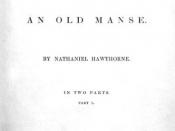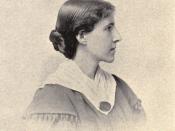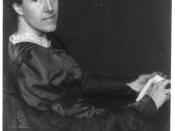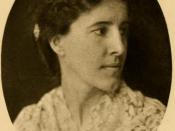Self-Deception Charlotte Perkins Gilman and Nathaniel Hawthorne are two authors with detailed backgrounds that when understood help give insight to their short stories, novels and plays.
Charlotte Perkins Gilman was the last child born to her mother and father on July 3, 1860. Gilman?s father left her mother after she was instructed not to bare anymore children. In ?To Harland and Beyond: The Life of Charlotte Perkins Gilman by Anne J. Lane, Gilman is described as a young girl who developed the idea early in life that marriages are vain and not important. Although Gilman felt this way, she found herself in two different marriages. In the first marriage she gave birth to her daughter, this lead to depression, which inturn lead to the destruction of her marriage. Her second marriage was to her first cousin, George Houghton Gilman, and they remained married until his death. After his death, she moved to California while trying to recover from a deep depression.
Gilman then became known for her lectures and writing on women?s topics. In 1932 Gilman discovered she had inoperable breast cancer; three years later she committed suicide. Gilman decided to die fast by poisoning herself, rather than to live in misery and die a slow painful death.
Another author of great magnitude, whose biographical information is pertinent to a lot of his literature, is Nathaniel Hawthorne. Nathaniel Hawthorne was born on July 4, 1804 in Salem, MA, where he grew up with his widowed mother. As a child he was seriously injured and had to spend the majority of his childhood inside where he developed his love for literature as described in the ?Biography of Nathaniel Hawthorne? by Jodi DiGrazia. Hawthorne was heavily influenced by his Puritan heritage. He added a ?W? to his name to disassociate himself from ancestors who were greatly involved in the Salem Witch Trials. Hawthorne became a great author, and a genius among his peers.
Charlotte Perkins Gilman and Nathaniel Hawthorne are both authors who use setting and character to give the reader a first person perspective. In the book, The Elements of Writing about Literature and Film, by McMahan, Funk, and Day, setting and characterization are two the elements of fiction that are analyzed. Setting is the place and time during which the novel or play takes place. (13) Characterization is to know the character by their moods and tones during the play, story or novel. (17) In Gilman?s ? The Yellow Wallpaper? and Hawthorne?s ?Young Goodman Brown? setting and character are combined to provide an analysis of the protagonist struggle with self-deception.
The setting in ?The Yellow Wallpaper? uses very descriptive words and phrases to get the reader more involved in the story. In the ?The Yellow Wallpaper?, Gilman used the thoughts from Jane?s mind to describe the home she lived in, and how it disturbed her so much. At the beginning of the story, she compares the room that she is living in to a jail; ?it has bars on the windows?. This makes the reader feel enclosed with her, because the story is now going to take place in a jail type setting. Also in the story, Jane discusses how she hates the look and the smell of the wallpaper, ?it is torn off in places and appears to have bubbles in it?. Jane tells the story of how the wallpaper is going to become the death of her. ?I am getting angry enough to do something desperate. To jump out of the window would be admirable exercise, but the bars are too strong even to try.? During the entire story, Jane attempts to overcome her depression by defeating the wallpaper, but instead losses all self-control and sanity in the process.
Jane?s self-control and sanity is a very important part of her character. In ?The Yellow Wallpaper? Gilman used Jane to portray the mentally ill protagonist. The protagonist is the main character in a drama or fiction. Jane?s character is a woman who has a serious case of depression and has been diagnosed by several doctors who find nothing wrong with her. ?If a physician of high standing, and one's own husband, assures friends and relatives that there is really nothing the matter with one but temporary nervous depression--a slight hysterical tendency-- what is one to do?? Jane?s husband, John, a physician, believes that relaxation and being a domestic will cure her tiredness and fatigue, though Jane thinks work and writing can help her asses her mental illness. ?Personally, I believe that congenial work, with excitement and change, would do me good? in my condition if I had less opposition and more society and stimulus--but John says the very worst thing I can do is to think about my condition.? Jane has deceived herself into thinking that her own treatment and diagnosis is better than any doctors are. This is a good example of the protagonist struggle with self-deception.
?Young Goodman Brown? is also an example of the protagonist struggle with self-deception. In ?Young Goodman Brown?, Hawthorne tells the story of a man whose setting is a small town village with Christian people whom Goodman socializes with regularly. In the beginning of the story, Goodman briefly describes his surroundings as he travels into the woods while leaving his wife, Faith, behind. Goodman knows that the night ahead of him will be filled with new territory and difficult obstacles, but he proceeds with his mission. Hawthorne describes how Goodman is unaware of his immediate future but still proceeds on: He had taken a dreary road, darkened by all the gloomiest trees of the forest, which barely stood aside to let the narrow path creep through, and closed immediately behind. It was all as lonely as could be; and there is this peculiarity in such solitude, that the traveler knows not who may be concealed by the innumerable trunks and the thick boughs overhead; so that, with lonely footsteps, he may yet be passing through an unseen multitude.
The reader knows that Goodman Brown is determined to travel on even though he has a comfort zone at home with his wife, Faith. As the story tells on, Hawthorne describes how Goodman encounters human and animal sounds all at once. Goodman is unaware that he is traveling through a forest filled with evil and satanic mystery. ?Goodman Brown heard the tramp of horses along the road, and deemed it advisable to conceal himself within the verge of the forest?On came the hoof-tramps and the voices of the riders?. Goodman is well aware that he is now uncovering secrets that the woods have held for a long time. The setting that encamps him now, is a setting of people and things that he thought were holy people and a simple forest, but he knows now that that is not the case. Goodman wants to think that these new things that he is hearing and seeing aren?t real, but he can only believe what his eyes are telling. Goodman has not become confused between what is real and pure with what is unreal and hallucinogenic.
Goodman struggle with what is real and pure is a game he is playing with himself. The people involved in this game are the town?s people and his wife, with whom he?s with everyday. The protagonist in this short story is Goodman, but his counter part, Faith, is the antagonist. The antagonist is the character in drama or work of fiction whose actions oppose those of the protagonist. Faith?s character is described to be Goodman?s angel, but later in the story she becomes apart of a satanic cult. This gives Goodman a distorted picture of his wife, even after he emerges from the woods. Goodman has no proof that his wife is the devil, but from now on he refuses to allow himself to love her same as before.
In conclusion, Charlotte Perkins Gilman and Nathaniel Hawthorne?s lives played a huge part in the story they wrote. Gilman analyzed her life through her writings of a woman who everyone thinks is slowly going crazy except her. Her theme in ?The Yellow Wallpaper? can be interpreted differently, but to me she tries to help other women in their personal struggles. Even though at the end Jane became crazy, her actions and written words have and will help many women to come. Gilman?s work will not go unrecognized, as long there are women who suffer from depression.
Charlotte Perkins Gilman?s work is similar to the work of Nathaniel Hawthorne. Hawthorne did not suffer from depression or insanity, but his childhood like Gilman?s sparked his writing career. His writing about ?Young Goodman Brown? was mostly about his life as he tried to pry himself from ways of the Puritans. The theme in Hawthorne?s story can be interpreted differently due to the fact that many are unaware if the story was real or was it a dream. The point he is trying to get across is that everything may not be actually what it seems to be. Like Gilman, Hawthorne?s work will also never go unrecognized as long as there are readers who minds crave insight on life after the Salem Witch trials.
Works Cited DiGrazia, Jodi ?Biography of Nathaniel Hawthorne? 16 February 2002 www.geocities.com/ibenglish_chs/hawbio.html Gilman, Charlotte Perkins ? the Yellow Wallpaper? 18 February 2002 www.cwrl.utexas.edu/~daniel/amlit/wallpaper/wallpapertext.html Hawthorne, Nathaniel ?Young Goodman Brown? 20 February 2002 www.cwrl.utexas.edu/~daniel/amlit/goodman/goodmantext.html Lane, Anne J. ?To Herland and Beyond: The Life and Work of Charlotte Perkins Gilman? 17 February 2002 www.womenwriters.net/domesticgoddess/gilman1/.html






